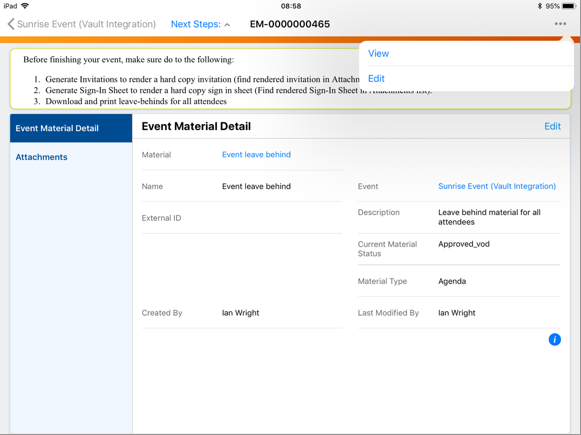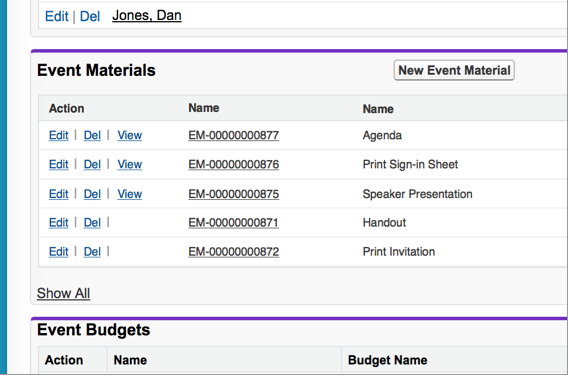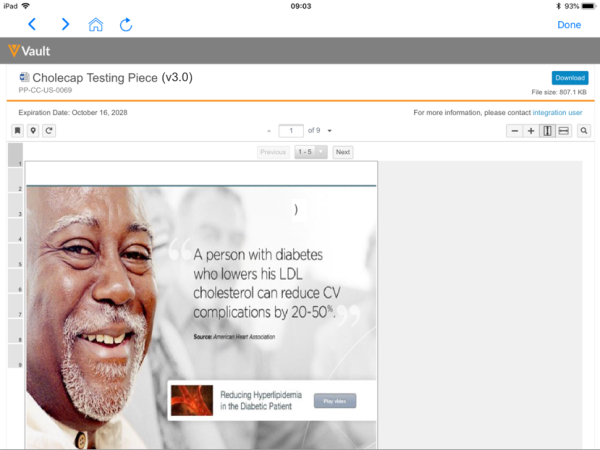Managing Event Materials
- Browser
- iPad
Event Materials can be associated to an event. Event Material examples include, but are not limited to, the following:
- Speaker presentation decks
- Event agenda templates
- Print invitation templates
- Brochures and Flyers
Customers can configure materials so they are automatically available for an event by event type, country, event product, and event topic. For example, if a user creates a Speaker Program in the United States with a topic of “Cholecap Efficacy”, a core set of materials can be associated to the event automatically to give the user a starting set of materials used for the event.
Materials are stored in the EM_Catalog_vod object using the following record types:
- Presentation_vod
- Print_Invitation_Template_vod
- Print_Sign_In_Template_vod
- Speaker_Presentation_vod
- Custom record types
Materials associated with a particular event are stored in the EM_Event_Material_vod object. The record types on this object should correspond directly with the same record type names as those used on the EM Catalog.
Event Materials are typically approved before they are available for use and are re-used for events of the same type or similar topic. Veeva enables users to quickly find relevant materials for the event and allows organizers to indicate which materials were used for the event. Additionally, administrators are able to audit events to determine how often materials are being used and to review expired material.
Configuration
To configure this feature:
-
Grant admins the following permissions:
Object OLS Record Types Fields FLS EM_Catalog_vod CRUD - Presentation_vod
- Print_Invitation_Template_vod
- Print_Sign_In_Template_vod
- Speaker_Presentation_vod
- Description_vod
- Name_vod
- Status_vod
Edit EM_Topic_Material_vod
CRUD
- Topic_Material_vod
- Product_Material_vod
- Material_vod
- Material_Type_vod
- Topic_vod
- Product_vod
Edit
EM_Event_Material_vod CRUD - Presentation_vod
- Print_Invitation_Template_vod
- Print_Sign_In_Template_vod
- Speaker_Presentation_vod
-
Event_vod
-
Material_vod
-
Material_Type_vod
Edit EM_Event_Rule_vod
CRUD
Material_vod
- Country_Override_vod
- Event_Configuration_vod
- Material_vod
- Material_Type_vod
Edit
-
Grant end users the following permissions:
Object OLS Record Types Fields FLS EM_Catalog_vod R - Presentation_vod
- Print_Invitation_Template_vod
- Print_Sign_In_Template_vod
- Speaker_Presentation_vod
- Description_vod
- Name_vod
- Status_vod
Read EM_Topic_Material_vod
R
- Topic_Material_vod
- Product_Material_vod
- Material_vod
- Material_Type_vod
- Topic_vod
- Product_vod
Read
EM_Event_Material_vod CRU - Presentation_vod
- Print_Invitation_Template_vod
- Print_Sign_In_Template_vod
- Speaker_Presentation_vod
-
Event_vod
-
Material_vod
-
Material_Type_vod
Read EM_Event_Rule_vod
R
Material_vod
- Country_Override_vod
- Event_Configuration_vod
- Material_vod
- Material_Type_vod
Read
-
Override the following EM_Event_Material_vod buttons with the following Visualforce pages:
- Edit – Set to EM_Event_Material_Edit_vod
- New – Set to EM_Event_Material_Edit_vod
- View – Set to EM_Event_Material_View_vod
-
Grant all users access to the following Apex classes:
- VeevaApproveDocMaterial
- VeevaCatalogMaterial
- VeevaMaterial
Administrators
Administrators determine what material gets used, who uses it, and which events the material can be used for. To manage materials:
- Create a new EM Catalog record to store the material metadata.
- Upload the .docx template to the EM Catalog record that was just created.
- Create a new Event Rule to define which event types and countries can use the material.
- Create a new Topic Material record to define which topics use the material.
- Ensure users have the proper permissions to use the corresponding materials.
Users
Users on an event team can perform the following steps:
- Add materials from an approved list to an event.
- View materials added to an event automatically or by other team members
- Indicate which materials were used to close an event and maintain accurate history.
- Select a template to use for print invitation and generate the pdf to print the invitation.
Templates
The EM Catalog stores two types of materials:
- Print invitations with a .docx attachment of the actual invitation template
- Metadata for other material types, for example, speaker presentations or agendas
There are three ways to add a template to an event:
- Event Rule – associates a print template to a particular event type and country combination
- Topic Material – associates a print template to a particular event topic or product
-
Manually – A new Event Material record is created manually to associate an existing print invitation template in the EM Catalog to an individual event. To enable this option, place the New button on the Event Materials related list on the Event page layout.
Event materials that reference a material in the EM Catalog automatically copy all fields with the same API name from the EM Catalog record. These copied field values are not editable on the Event Material record.
- If manually creating an Event Material, the lookup value (Material_vod) from the Event Material to the EM Catalog is filtered to display only EM Catalog entries with the same record type name. For example, if the user selects the Presentation record type when creating an Event Material, the user can only populate the Material lookup with records of type Presentation from the EM Catalog.
A template can have a status of Approved, Expired, or Staged (default). When selecting a template to add to an event via an Event Rule or Topic Material, only EM_Catalog_vod records with a status of Approved_vod display as available. When manually assigning a template to a specific event, EM_Catalog_vod records with statuses of Approved_vod or Staged_vod display as available.
Printing Invitations
Users can generate a printable invitation based on pre-defined templates to give to attendees in person before an event.
Admins can create and define templates that are available for users to select from when printing event invitations. Since invitations vary by event type, country, and event topic, admins need to associate the template to configuration records in order to control where it is available. Users can then select the template to use to print invitations.
Components
- EM_Catalog_vod object – used to store documents related to Event Management
- Print_Invitation_Template_vod record type – Stores template metadata and a .docx attachment of the print invitation template
- Status_vod on the EM_Cataog_vod object – Indicates the status of the material
- Event_Rule_vod object
- Material_vod record type – Defines which templates are associated to an event configuration
- Material_vod field on the EM_Event_Rule_vod – Defines the template used for an event configuration
- EM_Topic_Material_vod object
- Topic_Material_vod – Defines which templates are associated with an event by event topic
- Product_Material_vod – Defines which templates are associated with an event by event product
- Generate_Invitations_vod button on the EM_Event_vod object, Event details page layout – displays a list of available templates for the user. Once selected, the template merges with data from the event. A PDF attachment is added to the Event so the user can print the invitations.
Templates
Templates are created by marketing or admin users. The template contains tokens that pull information from fields in various objects and are merged together for the final invitation.
The following tokens are supported:
- Event Fields – from the EM_Event_vod object
- Token format: {{EM_Event_vod__c.Field APIName}}
- Attendee Fields – from the EM_Attendee_vod object
-
Token format: {{EM_Attendee_vod__c.FieldAPIName}} – If attendee fields are referenced, one invitation generates for each attendee. For example, if a one-page template references attendee name and the event has ten attendees, the generated .pdf contains ten pages, one for each attendee.
If no attendee tokens are included, only one copy of the print invitation is generated.
- Event related data – from Event Speaker and Event Session objects only
- Token format: {{EM_Event_Session_vod__c.FieldAPIName}} – Tokens are placed in a table or in a string of text. Data is repeated in the final output for each record in the related table. For example, if a token references the Event Speaker Name, and there are two Event Speakers, both Event Speakers display in the final output.
- User data
- {{User.FieldAPIName}} – Name, phone, email of user generating the invitations
- Relationship fields from the above list of supported objects up to one level deep
- {{ObjectAPIName.RelationshipName.FieldAPIName}} – For example, {{EM_Event_vod__c.Vendor_vod__r.Phone_vod__c}} is supported while {{EM_Event_vod__c.Vendor_vod__r.Account_vod__r.Phone_vod__c}} is NOT supported
See Formatting Tokens to Display Date and Time for more information about specifying the displayed date and time format for a token.
Only include CRM tokens in the body of the .docx template. Tokens in the header, footer, or text boxes of the document are not supported.
Example .docx Template Input
|
Session Name |
Location |
Time |
|---|---|---|
|
{{EM_Event_Session_vod__c.Name}} |
{{EM_Event_Session_vod__c.Location_vod__c}} |
{{EM_Event_Session_vod__c.Start_Time_vod__c}} - {{EM_Event_Session_vod__c.End_Time_vod__c}} |
Example .pdf Output File
|
Session Name |
Location |
Time |
|---|---|---|
|
Keynote |
Ballroom A |
9:00 – 10:00 |
|
Breakout Session: Cholecap Efficacy |
Ballroom C |
10:00 – 10:30 |
The Veeva merge engine copies all formatting from the original .docx template into the output file.
Requirements
The following conditions must be met when making an Event Material Template:
- File extension must be .docx
- File must be less than 1MB in size
- File must contain at least one CRM token
- Custom fonts must be embedded in the .docx file if used
- Avoid overlapping images, tokens, text, and tables
- Use tables to organize text. Do not merge rows and columns in tables with repeating data
- Select the Repeat Header Rows setting on a table's properties to repeat the table row header
- Use the Space + Enter command in Word to maintain the grouping of data across multiple lines
- Use the header and footer of the document to insert images
- Compress images to help reduce the template's file size
Use
To print invitations:
- Create a new EM Material record of type Print_Invitation_Template_vod.
- Upload a template with tokens with file type .docx to the new record.
-
Create a new Event Rule or Topic Material to automatically associate a print template to an event type or topic.
- These rules automatically associate the print invitation template to newly created events that match these criteria
- Alternatively, a print invitation template can be manually associated to an event by selecting the New button on the Event Materials related list on an Event detail page
-
Place the Generate_Invitations_vod button in the Visible_Buttons_vod field of an Event_Layout_vod record that is being used by an event team member to view an event.
- When a user selects this button, a list of available print invitation templates displays with a preview image
The user then selects a template, and the template and merge data is sent to Veeva’s document generation engine for data merge. The.pdf output is stored as an attachment on the event the user can open and print.
Data merge is an asynchronous process that may take several minutes depending on the size of the template, the amount of data being merged, and the existing queue. Inserting the document relies on a valid user session. If the user logs out while waiting for an attachment, the attachment is added the next time any user accesses the event. If the event is not accessed in 7 days, the user must regenerate the invitations.
Enhanced Event Material Availability
To improve accuracy and increase compliance when organizing events, users have the latest content available when selecting event materials. This includes newly created or recently updated records that may not display as available by default.
For example, Sarah Jones organizes an event and sends an Approved Email invitation to attendees. When she views the list of Approved Email Templates to select for her event, her list of templates is automatically compared to the list on her org. Any missing or out of date templates are created on Sarah’s device before the list displays to her.
This feature does not require configuration.
Considerations
- The following content types are supported by this feature:
- Approved Email Templates
- Print Invitation Templates
- Print Sign In Templates
- Speaker Contract Templates
- The following content types are not supported by this feature:
- Vault Linked Materials
- Custom record types
- New EM_Event_Material_vod records are created to ensure the most up to date content is available
Selecting Event Materials
When users view a list of any of the supported content types, the list available to the user is compared to the same list in the org. Any missing or out of date materials are created or updated before the list displays to the user.
Event Material records are not updated for existing events if existing content is not changed. Existing EM_Event_Material_vod records are updated when one of the following is true:
- New content is available
- One of the following fields are updated:
- Topic_vod
- Country_vod
- EM_Event_Configuration_vod
The Last Modified timestamp indicates when an event material was updated.
Optional Tag in Tokens for Printing Invitations and Sign-ins
-
Browser
For fields that are not required in a template, for example for Print Invitations or Sign-In, an Optional tag can be inserted into a token so the system can populate that information or leave the field blank if there is no value for that field.
For example, if Address Line 2 has a value of Suite 210, and the token includes the O for optional, the token is {{EM_Event_vod__c.Location_Address_Line_2_vod__c<O>}} and that value would display in the output. If the Event does not have a Location_Address_Line_2_vod value, the token is replaced with a blank value because the token is indicated as optional.
Viewing Event Materials from Vault
- iPad
-
Browser
Events Management supports viewing Vault documents directly from event material records in CRM. This integration enables greater control over event content by ensuring only the most recent and approved material displays for events.
Only the latest Approved steady-state version of the Vault document displays.
For example, Sarah Jones’s company stores the template for ad-board agendas in Vault. The template in Vault links to an EM catalog record in CRM. Sarah views the most recent template in Vault directly from the event material record in CRM, even though she does not have a Vault login.
Configuration
To configure Event Materials in Vault:
- Ensure the Approved Email Integration user is properly configured in CRM.
- Ensure the appropriate event material is in a steady-state in Vault.
- Ensure the Integration user can view the appropriate event material in Vault.
- Grant end-users FLS read and administrators FLS edit permission to the Vault_Link_vod field on the EM_Catalog_vod object.
- Add the View_vod button to the list of visible buttons on the EM_Event_Layout_vod record associated with the Event Material record type.
Use
To link a Vault document to an EM_Catalog_vod record in CRM, paste the Vault document’s complete URL into the Vault_Link_vod field of the corresponding EM Catalog in CRM.
A View button displays for event material records created using the linked EM catalog record.
-
For all platforms, the View button displays on the event material record’s detail screen

-
On the Browser platform, the View button also displays next to the event material record on the event detail page

Selecting the View button displays the Vault document in each platform’s native browser using the External Vault Viewer.

Document views from this feature do not count toward document view license limits in Vault.



